Stories from the Hood, Part Nine- The Murals

Stories from the Hood
The Murals
Chapter Nine
Introduction
One afternoon last summer, I was about to ascend my ladder to do some restoration work on the front of my house when a stranger walked up to me. He was thirty something and dressed out of a Banana Republic catalog.
His tone was acrimonious as he asked, “Don’t you have any zoning regulations in this neighborhood? It appears that the people here can do anything they want to with their houses.”
I did not have the time or the inclination to engage in conversation with this man as I replied, “There is not a home owner’s association in this neighborhood, if that is what you mean. We are allowed to fly any size of the American flag that we wish, and we don’t have to choose between three shades of beige to paint our houses. This is what gives this neighborhood its character and this is why the people living in this neighborhood love it here. What brings you to this part of town? You look lost.”
He replied, “I live in Highlands Ranch [a suburb in Southern Denver]. My wife is trying out a new beauty salon just down the block from here and I am out on a walk waiting for her.”
I told him, “I trust your wife will leave our neighborhood more beautiful than she arrived but if you will excuse me, I have work to do.”
With that we parted ways. He had just passed my neighbor’s houses and noticed one of the houses had a geodesic dome sculpture in the front yard, another had a gabion designed into a mailbox (chicken wire filled with stones), a house with a multi-colored picket fence, another neighbor’s home looks out of the hollers of Appalachia with a dead tree painted blue, and another neighbor leaves giant Halloween spiders on his house year round. The stranger had not even gotten around the corner of my house to notice the climbing sculpture of Spiderman.
I could only be reminded of my old friend Bill Amundson’s drawings. Bill drew hilarious pictures which commented on homogeneous matchbox neighborhoods, such as the kind this visitor seemed to thrive in. The farm lands that once surrounded Denver gave birth to these visually-analogous housing developments with the exponential speed of a wildfire over the prairie lands.




Of note: Claude Monet is mostly famous for his large impressionist paintings of waterlilies from his gardens in Giverny, France. He was also quite famous for his paintings of haystacks entitled “The Stacks at Giverny” which were done from the summer of 1890 through the following spring. Monet painted haystacks to show how the same subject matter changed with light and atmosphere throughout the day during different seasons and weather, although the difference between one haystack and another is even more pronounced in Bill’s drawings when compared to the conglomerate retail establishments that decorate our landscape – which do not seem to change with the light of day or weather.


A walk down the block – a few unique expressions as described above. The rat made a fun and startling appearance at my rose bush one day and has been there ever since.
The History of the Murals
Before I started work on Spiderman, I had no idea how I was going to make him. He was just a figment of my imagination before I met Nikki (chapter eight, Spiderman). Before Spiderman fell into place, the full idea began with something more tangible. There were large inset spaces on the house that I had always wanted to create murals for. These natural rectangular spaces were the sealed off remnants of where store front windows and a door had once existed in bygone days. During the long restless nights triggered by chemotherapy, I started to paint a set of four murals that I designed for these vacant spaces of the house.
One tangent of thought on the murals was to discourage the unwanted graffiti on my house by putting up something that graffiti perpetrators might respect and hence, not violate. As such, I kept coming back to something Pop-artish and graphic to accompany Spiderman, the flag, and the gargoyle. I decided to create four large mural panels of comic book characters which encompassed both male and female role models. In recognition of the multi-ethnic history of the neighborhood, I used a different language in each panel. One was in English for obvious reasons, one in Italian for the early history of the neighborhood, one in Spanish to reflect the recent past, and one Japanese in recognition of the hood’s Japanese war-brides and the history that I brought with me to this house.
The murals were also inspired by all the graffiti that I have observed in my neighborhood back then. I’ve always found the rebellious nature of graffiti interesting as a visual form of personal expression propelled into the public realm; a momentary cry out of a void we prefer to deny the existence of, thrown in our face. Graffiti can be of a quality that elevates it into a gray area somewhere between vandalism, social reflection, and high art. It is a renegade’s language in direct opposition to law and social taboo. Art is often described as a reflection of our culture; graffiti is born of our social condition. The spirit and passion behind both can be similar.
Graffiti is a human experience that has been around since prehistoric times. One neighborhood graffiti artist even put his hands on my house and sprayed over them with spray paint – exactly like the cave painters did thousands of years ago. It was a human archetypal expression that has been repeated through the ages and it was with reluctance that I painted over them. With such a rich tradition, graffiti will continue to thrive and surface as part of the collective psyche.


Chauvet Cave in Southern France is absolutely the most amazing cave of prehistoric art found to date. It was only discovered in 2010 and dates back 32,000 years. It is in such pristine condition that it appears to have been occupied by its inhabitants yesterday. The hermetic preservation of this vast cave is far greater than even King Tut’s tomb with the ashes of the extinguished fires still in tact as if they just died out. Werner Herzog directed a film about this cave, entitled “Cave of Forgotten Dreams”. It is a documentary available on Netflix. This film is guaranteed to blow you away with sheer awe while stifling your imagination beyond its limits.
Also included below is a famous Aboriginal hand print from Australia with a missing finger. This is my favorite prehistoric hand print because it has a unique story which draws you into imagining the life of an individual who existed 40,000 years ago.
The neighborhood tunnel is the perfect graffiti showcase given its pristine concrete walls and the volume of viewers that pass through. At night, the tunnel is off police radar, so it is an easy mark. Using the world as their canvas, graffiti artists often emerge there to leave visual messages. Graffiti makes me stop and sets my desire to understand it in motion, because I enjoy analyzing the mind of the culprit much like a psychotherapist or detective reads the mind of someone by clues left behind. The anger and frustration within a message can be a comment about our times or simply an abstract expressive mark. Sometimes it is as basic as gangs marking their territory, just as dogs leave their scent. Professions of love are analogous to carving hearted initials into tree bark. Ithyphallic expression of male sexuality and fertility abound. Some street artists even have their own style with a recognizable tag name.
With the elevation of graffiti to high art these days, there are many an essay written on the subject. I find the differences between graffiti and murals to be engaging thought fodder. Murals take time, graffiti must be done quickly. Murals are censored for public consumption, graffiti is not. Whereas a mural lasts until it deteriorates, graffiti is made with the knowledge that it will vanish with the blink of an eye – the city’s graffiti squad uses an assorted palette of gray paint to cover graffiti as soon as it appears and the city knows well the popularity of the tunnel for graffiti. The lifespan of a graffiti in the tunnel is usually less than 24 hours (Sundays and holidays offering a slightly longer exhibition run). If you want to see the show, you need to come by the next morning before the display gets taken down. There is an element of luck and privilege in knowing you are witness to something that soon will be gone and forgotten. I always enjoy imagining the excited moment and circumstance under which the deed was perpetrated. Although I was never a graffiti artist, I did have my day with “street art”. Those days were very influential in my thinking behind the street art for my house.
Some graffiti from the tunnel.
This is my favorite neighborhood mural. It gives the witty illusion of “closure” that it is half buried with the figure emerging. This artist also has a mural of the same motif on a building in the neighboring area of Globeville. Perhaps his tag name is “belove”.
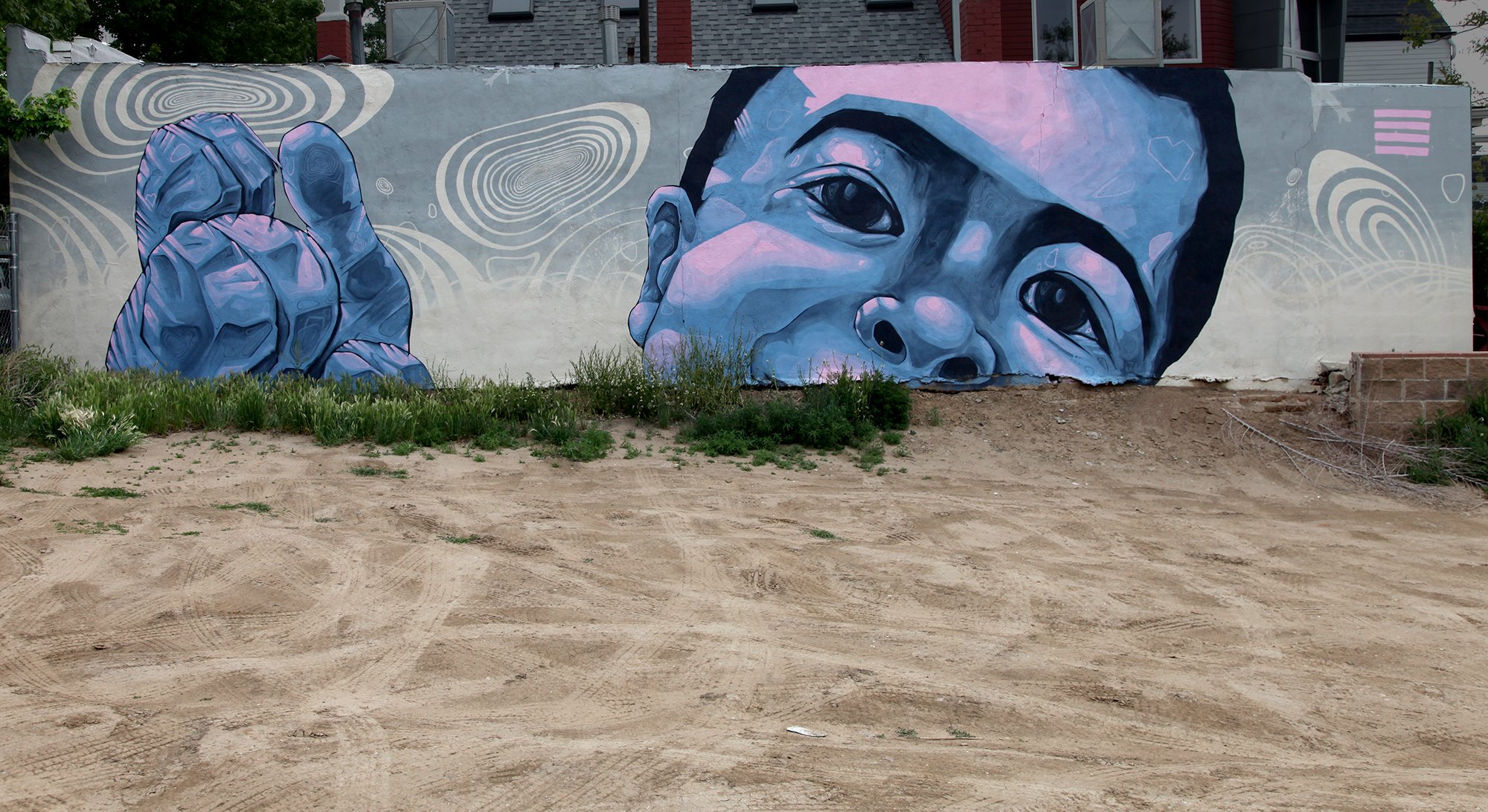



Another favorite mural is this panel from the Keating/Luna epic neighborhood panels,1993. This panel simply depicts a scene before mass development – a very quiet winter’s day with two lone trees back-lit by the radiant sun next to the flowing blue, yet unpolluted, water of the Platte River. The mosaic tiles themselves give the feeling of falling, glistening snow. It is the quiet of this landscape that I find peace in when I pass. It lies directly across from the Guadalupe Church.


The idea to make my own unbidden public art statements evolved back in 1975, when I was partners in crime with one of my students. We banded together and called ourselves “the art terrorists”, the word of an era prior to “terrorist” meaning what it does today. The Vietnam War had ended and we had entered into the sleepy 70’s where American interest transitioned from idealism into materialism. As “art terrorists”, we simply meant to challenge the status quo with what we considered to be in a kindred spirit to the Dada art movement of 1920’s Europe. In a Dada frame of mind, we made public art statements that were meant to sacrilegiously challenge the absurdity of being, as we knew it, expressed through the creative seeds of mischief that abounded in my life at that time.
note: The Dada art movement was a reaction against the post WWI rise of Capitalist culture in Europe during the early 1920’s. While seemingly flippant on the surface, it was fueled by disillusionment and moral outrage at the carnage of WWI. It broke from traditions, creating new ways to replace the old. Dada is often characterized by irrationality, satire, enigma, anti-bourgeois sentiment, irreverence, mockery, absurdity, unpredictability, nonsense, anarchism, revolution, and a questioning of everything taken for granted. The word “Dada” itself is nonsense. Dada is infused with clever wit and a bizarre sense of humor (often dark). In experimenting with the laws of chance and the “found object” (called “ready-made” art), the definition of art was challenged as never before. It turned out to be one of the most influential movements in modern art, fueling surrealism and giving fertile ground to Conceptual art and Pop art. At times when the world seems to make no sense, the impact of Dada art resurfaces and is as alive today as ever.


A performance by Hugo Ball reciting the sound poem “Karawame” at Cabaret Voltaire in 1916, in which he recited nonsensical syllables in patterns to create rhythm and emotion. He was referencing the inability of European powers to resolve their diplomatic problems through civilized and rational discussion, a dilemma that led to WWI – equating the political situation of that time to the story of the Tower of Babel. It is certainly an easy jump to find meaning in this performance over a century later.


“Mechanical Head (the Spirit of our Time)”, 1920, by Raoul Hausmann. This piece is a reference to man being empty-headed with no more capabilities than that which chance has glued to the outside of his skull… another comment on the politics of the time which is easy to relate to today.
In 1975, I was teaching silkscreen and photography at the Cooper School of Art in downtown Cleveland. On top of the three-floor school building was a commercial billboard that I got clearance to use for a photography assignment with my students. This project was in connection to a lecture I gave on the perceptual laws of continuity and Gestalt psychology. For this assignment, I cut up a picture and gave each student a piece. Only I knew what the sum of all their pieces added up to. With their unique piece of the puzzle, they proceeded to create a photograph using the same composition with similar design elements as was in the piece they were given. I had marked the important edges on each piece that had to be the same in their photographs. As such, the visual edge of one student’s photograph would line up with the corresponding edge of the photographic piece next to it. This idea was a variation on a game called “The Exquisite Corpse” that the Surrealists came up with in the early 1920’s. In this game, one artist would do part of a drawing, fold the paper so only the edges of their drawing could be seen, and pass it on to another artist who used the ending edges of the previous drawing to begin the lines of a new drawing with. The resulting drawing was great fun to reveal after all the artists had blindly contributed their part to the whole.
Some fun examples of “Exquisite Corpse” drawings done by members of the original Dada and Surrealist movement in the 1920’s.
More examples of “Exquisite Corpse” drawings by miscellaneous artists and students of all ages.
After the students had shot their film and chosen their final images, we reorganized the darkroom to make huge prints on cheap mural paper and proceeded to project and process the sizable photographs in teams. I notated a loose color palette for each student to use on their finished print and taught them how to hand-color their photos. When we put them all together, lines connected enough from one image to the next, with enough continuity in the composite image to form a giant single image, like a giant Gestalt jig-saw puzzle. When we pasted them all up on the billboard, the image of a scaled, twisting dragon appeared. It was during that project that an exciting and intriguing philosophical dialogue developed between myself and one of my students in particular. Subsequently, my new partner in crime and I plotted to take the Dada billboard idea a step further into the realm of the taboo – and to have a daring good time with it.
After purveying various billboard locations in Cleveland for high visibility and accessibility, we visited our chosen site to brew up our plan and get the lay of the land. Our scheme utilized a prominent billboard on Murray Hill Road, one of the main arteries that lead into the University Circle area of Cleveland. During rush hour, this road was heavily congested with traffic. We “altered” this billboard five times over the course of six months, transforming the existing advertising into our own Pop culture Dada art statements.
For our first billboard alteration we violated a Winston Cigarette Man advertisement. We did him in broad daylight, in the middle of rush hour, with traffic whizzing by us as we worked. With tongue-in-cheek, we disguised ourselves to appear like stereotype billboard painters on the job; we dressed in white painter’s overalls, had red handkerchiefs hanging out of our back pockets, and wore white painter’s caps. Each planned color of paint was premixed in its own cup, with a dedicated brush which fit into the pockets of our overalls. We spent several evenings having fun, planning out the colors and sections that each of us would be responsible for – as precisely as one would hatch a plan for a bank robbery. Our plan was to paint the Winston Man in drag with our Dada signature. Our serial reign of art terrorism had been born.
On the day of the execution, we brought our own ladder to make the ascent up to the billboard. When the rush hour traffic was at its peak, we ascended up the billboard scaffolding. At the bottom edge of the billboard was a small ledge that we could carefully stand on. With our faces up against the surface of the billboard, the existing image looked like little more than mammoth half-tone dots as we calculated the placement of our brush strokes. We relied on our panache being so confident and flamboyant that no one would question us. We were just professional billboard painters doing our job.
We had seen enough bank robbery movies to create a well thought out plan for a strategic get-away if the police came after us. We calculated being able to spot anyone heading in our direction with enough advance notice to descend the billboard and run with our ladder in the opposite direction. We banked on the assumption that the police would not have a ladder. A short distance away, there was a vertical, one-story drop to the railroad tracks that could only be reached with a ladder. We would descend this vertical drop with our ladder, cross the railroad tracks, and ascend up the opposite wall, pulling the ladder up behind us. At that point, we would wave to the police with big smiles. My associate lived in a non-residential warehouse close by the tracks that we could then duck into and disappear. But ultimately no one bothered us, so we never got to execute our daring escape plan. Immediately following each art terrorist act, it was our ritual to go back to my cohort’s place, give it five, toast down a shot of whiskey, and then go back to our normal day as if nothing had happened – with the deeds and dyadic identities of our secret pact sealed between us.
The billboard alterations caught everyone off guard and the word-of-mouth news spread with quite a lively and delightful buzz about town. On the day after any of our billboard alterations, all our friends would be chit-chatting about it with excitement. It was great fun as my house-mates shared the exciting news of the latest billboard alteration with me and I pretended to be in the dark, like when a superhero has to keep his double-life a secret from those around him. To our surprise, our billboards were left up all month until the next commercial billboard replaced it. When a new billboard went up, we brainstormed what we would do with it and what the theatrical mode of execution would be. The next to go up was a totally green environmental billboard of some kind. We dressed in black like ninja warriors for that one. In the middle of the night, we attacked the billboard and painted across it with giant, dripping red paint that read, “Nuke the Whales”. That really made people wonder who we were. During that era, such a phrase was completely absurd and very much in our Dada spirit. For another, we contacted a billboard company pretending to be art students doing giant art collages and acquired the complete paper rolls for a billboard of the Black Velvet Whiskey Lady. We cut it up and used the pieces to design a Dada collage that we pasted up over the existing billboard. My favorite was the alteration of a billboard depicting the channel five news team. We painted black sunglasses on the four local news celebrities and wrote “Ignore Alien Orders”. Like the graffiti artists in the tunnel, I imagine our adrenaline rushes were similar and we subsequently returned to the scene the next day as spectators to gloat over our work.




Recently, I read about a group in California calling themselves an “activist art collective”. They wore hoods at night and doctored a junk removal billboard on a heavily traveled highway outside of San Francisco. Originally the sign said “We Make Junk Disappear.” Pasting up a photo of a child gasping in surprise, the art collective altered it to say “We Make Children Disappear” and signed it “ICE”. The vandalized ad was removed within hours of discovery but not before it hit social media and went viral. Viva l’arte de la rue.


Two of our local tunnel artists go by the tag-names “AtM” and “Rx”. These two have an interesting friendship and complimentary style. It is easy for me to imagine they have exciting times together conspiring, planning, and going out in the early morning hours to do their deed. It is not hard to create a profile of these two from the marks they leave behind.
My own fine art style is rooted in a world of dreams. My imagery is a visual study of the human psyche, the experience of existence, mortality, and the human condition. I am not a comic buff or Comic Con attendee [Denver’s annual, international comic convention]. Nor do I even know which characters are Marvel, DC, Darkhorse, or Valiant. It is simply a part of the culture that forms who I am and my use of them is in a spirit of cultural appropriation. The icons in these murals represent aspects of humanity. Although these super heroes are born out of the American culture, they are a part of all cultures. Some of the people I run into outside my door do not speak English yet their smiles speak volumes.
The ideas behind superheroes are accessible to many kinds of people. All children are in love with them. I personally find symbolism and meaning in my own life within the stories of Spiderman, Batman, and the Green Arrow. They are tales about the battle between the good and evil forces of the universe – this is something people always need to see more of. There is hope for the underdog who believes in an ideal and stands up for it. They are normal people with struggles and traumas, who transcend their normality. They inspire us to deal with adversity. They show us how to make the right decisions, even when they are tough, and live with a vision for humanity. Super heroes overcome their doubts and demons and then act to make the world a better place. The blessing of their powers also being their curse. Joseph Campbell talks about the mythology of a super hero who battles “supernatural” forces and returns home “from this mysterious adventure with the power to bestow boons on his fellow man” in the tradition of great mythology. They undergo life altering experiences starting with trauma, progressing to destiny and finding meaning in taking stock of their lives and choosing the right path. They tap into our empathy and compassion for others. They are characters that we all identify with and our fantasies aspire to. They influence young minds greatly, because we all need heroes. Robin Rosenberg, clinical psychologist writes “superhero stories are about morality and loyalty, about self-doubt and conviction of beliefs. I also saw that, like any good fiction, the sagas of superheroes bring us out of ourselves and connect us with something larger than ourselves, something more universal.” Then there are the demons who we all love that are some of the greatest fantasies of our worst nightmares.
The Resurrection
By the time I recovered from cancer, only two of the four panels were complete (along with the fiberglassed stage of Spiderman), when I decided to abort the whole project and move on.
For fifteen years, the two completed panels from the aborted mural project decorated my studio walls. The two blank panels laid in storage. After Spiderman was installed, completing the murals appeared to be something that would never come to pass. My own interest in the project had waned. However, in December of 2017, I received a visit that changed all that and brought the unfinished murals back to life. In that moment. the realization that the project was larger than me hit home hard.
It was a still, sunny day as I was gathering up the last of the dry fall leaves before the next snow set in. I came inside, with my dust mask still on, to get a drink of water when the doorbell rang. I opened the door to behold a beautiful Hispanic girl standing there, perhaps fourteen years old. She said she just lived down the street and asked me if I had made Spiderman. Encounters like this with strangers happen all the time and I had no reason to think this was any different. She went on to thank me with the usual compliment. So I just took my dust mask off, smiled a friendly smile, and accepted her good will.
She went on to tell me how she often passed by my house, with her three-year-old nephew Jonathan, to spend time visiting Spiderman. She told me how my Spiderman had brought a great amount of joy and happiness into his life and about how much he adored Spiderman. She continued her story of why she had stopped by to show her gratitude. As her story continued to unfold, it became clear that this was not just the usual complimentary drive-by.
She was on her way home from Jonathan’s memorial and got the impulse to reach out and ring my doorbell. A week earlier, little Jonathan was murdered in cold blood. When I asked for more details on the murder of this three-year old, she explained that his mother’s twenty-one-year-old boyfriend had suddenly, unexpectedly, out of nowhere, strangled him to death in a pure act of evil. No one had any forewarning that something like this could happen. She wanted me to have a photo of Jonathan and a green plastic bracelet from his memorial. I momentarily felt the breath knocked out of me and then thanked her deeply for the mementos like some zombie. I put them on the table and immediately went back to raking leaves, trying to feel like Voltaire’s Candide tending his garden, but in a minor state of shock. As the story sank deeper into my brain, I tried to process it, but it was too much. As the emotion built, I raked harder and harder with the crisp leaves rustling louder and louder in the air around me. This diversion became futile as snippets of our conversation echoed back and forth between my ears with the vision of Jonathan’s face in the picture that was just bequeathed with honor on me by this beautiful, young stranger. As catharsis set in, any semblance of control was lost when the dam behind my eyes broke with an explosion of tears, the rake dropped, and I just collapsed in the middle of a womb-like nest of musty autumn leaves. It was at that moment that a divine decision to finish the murals was made for me.


For that moment, “meaning” in my personal artwork paled to compare to the effect the art on my house was having on those around me. This was another chance to take art out of the private sector and bring it to the people of the streets. Thus the two unfinished panels were resurrected out of storage and the long process to complete them resumed. Their time had come. Spiderman had tested the waters.
A Coincidence in Time


“Neither snow nor rain nor heat nor the gloom of night nor deadly plagues will stay these couriers from the swift completion of their appointed rounds.” This motto is a tribute to America’s postal workers – with an update. I suspect that when Gerri is off duty from her heroic mission as a mail carrier, she lives a double life as Spidergirl.
I mentioned to our mail carrier, Gerri, that I was working on some murals, gave her a peek inside, and told her the story of Jonathan. She knew of the family and told me Jonathan often lived with his grandmother and young aunt who resided across the street in Corinne’s old house (see chapter seven, “Lost Between the Cracks”). Spiderman’s relation to that house now felt complete. It was a poetic thought to wonder if Jonathan and Corinne’s spirit had some connection. Could Corinne know of this gift to her and the impact it had on her behalf? Could Jonathan have been Corinne’s karmic reincarnation, like a Corinne Dahli Lama? Corinne and the Dali Lama would certainly have hit it off and that would have been a tea party not to be missed. It hardly seemed a coincidence but felt as if somehow, it was all connected.
Some Background on the Murals
My art has been inspired by our relationship to nature and Jungian aspects of the human psyche. Examples of this can be found throughout my website. The series “Human by Nature” explores this idea in particular.
“Human by Nature” statement:
Humans have always ascribed metaphoric, symbolic, and spiritual connections to other life forms: animals in particular. The spirit of other life forms has had an important influence on human identity from the beginning of time. Connecting with nature is a critical part of the human psyche and how we see ourselves; many believe this relationship contains power and a connection to the larger universe. The human psyche as it relates to animal attributes and what they represent in terms of power and character has been common throughout our evolution in every culture, and this association is as strong today as ever.
Some of the characters amongst this mural’s cast are a cross-species of the human race with such animals as fish, panther, spider, bat, and ram.
The Italian Panel
Top: Spiderman and The Black Panther
Middle: Elektra
Bottom: Batman, The Green Arrow, Captain America, and Aspen


Italian: METTI UN MIGLIAIA DI GUERRIERI SUL MIO CAMMINO…E QUELLO ANCORA NON È ABBASTANZA PER FERMARMI.
English translation: PLACE A THOUSAND WARRIORS IN MY PATH, AND THAT IS STILL NOT ENOUGH TO STOP ME!
Italian: L’ENERGIA PURA SCOPPIA NELL’ARIA CALMA, LAMPI CHE S’INFIAMMANO BRILLANTI INTORNO A LORO…COME UN VENTO SALTA SU DA NESSUNA PARTE.
English translation: RAW ENERGY CRACKLES IN THE STILL AIR, LIGHTNING FLARING BRIGHT AROUND THEM…AS A WIND SPRINGS UP FROM NOWHERE.
Note: Marvel character Elektra Natchios is the daughter of a slain ambassador with a troubled childhood. Elektra was trained to become a supreme martial artist and assassin by the ancient ninja cult known as The Hand. Elektra is a true antihero, she’s dangerous and deadly with a dark past, and she’s a woman motivated more by revenge than by righteousness. Elektra has been a presence in Marvel comics since the ‘80s and she lurks in a gray area between hero and villain, which has resulted in many rich stories.
Note: Fathom character Aspen Matthews is a beautiful and accomplished marine biologist and champion swimmer with a mysterious past. Eventually, memories of her mother and her early youth return to her, and she learns of her true nature. Aspen discovers that she has fantastical aquatic powers, as she has descended from a mysterious underwater race of humanoids called The Blue. Her passion for swimming and diving was more than just a hobby – it was her heritage. As an Elite Blue, she can manipulate water to her will, using it to create tsunamis and to even turn her body into water which can be separated and pulled back together if necessary. Most powerfully, Aspen controls all types of liquid, including the blood in other bodies. She also has the ability to heal wounds.
The Spanish Panel
Top: Batman battles the Ninja Man-Bats
Bottom: Spidergirl & Batwoman


Spanish: Yo estoy…
English translation: I’m in…
Spanish: La jungla se ensendío como…
English translation: The jungle lit up like……..
Spanish: Como fantasmas escribiendo en un espejo con uñas rotas.
English translation: Like ghosts writing on glass with broken finger nails.
Spanish: Ay dios Mio! Seiscientas libras de carne, cartilago y cuero.
English translation: Oh my god! Six hundred pounds of meat, gristle and hide.
The English Panel
Top: Scorn, Neckface
Bottom: The Green Arrow, Superman, The Joker


Note: “Great Scott!” was a common English phrase used when Superman first came out in 1938. It translates into present-day Millennial English jargon as OMG.
Note: Scorn is an alien prince whose father ruled a planet named Kandor. On Kandor, Prince Scorn could do whatever he wanted. But here, on Earth, he finds our world unethical and is expected to behave. He sees all the wrongs in the world and sees people harming their own brethren. He feels so much anger over this that he cannot contain his temper, which he is always losing over some injustice or another.
Note: Neckface is an anonymous American graffiti artist. His work is recognized for its darkly humorous, naïve drawing style, which often depicts ultra-violent scenes of monsters and humans. Born in 1984, Neckface began painting in his signature style around the year 2000. In 2002, he attended the School of Visual Arts in New York before dropping out in 2004. His commercial success has been highlighted by commissions as art director for Baker Skateboards and designing shoes for Vans shoes. Many of his Vans shoes are sold in limited editions. Like other anonymous street artists, including Banksy and C215, Neckface has begun exhibiting his work in commercial galleries. The artist lives and works between San Francisco and New York City.
Note: The Joker is a villain from the Batman story. He likes to take pictures of beautiful women. But instead of loading his camera with film, he loads his camera with acid and squirts it into his models’ faces, disfiguring them for life. “Smile and say ‘Cheese’, please, ha ha.” – Batman is always out to get this one. In the movie, the role seemed to have been written for Jack Nicholson and the amazing muscle control he has over his eyebrows.


The Japanese Panel


Note: The dragon in the top module was a black and white image I found in a Japanese manga. Manga is a unique Japanese literary form that could be likened to a comic book novel. I liked the words so much that I made them in English, so people could read them.
Rurouni Kenshin:
The Japanese writing under Kenshin’s picture is a mixture of the Kanji and Hiragana writing systems. It is the way his name, Rurouni Kenshin, is written in Japanese. In Japanese, the formal family name always comes first, his more personal “first name” is Kenshin.
Rurouni Kenshin is one of the most popular Japanese manga series to come out. The many episodes of Kenshin revolve around themes of atonement, peace, and romance. This manga has over 100 million copies in circulation.
Kenshin is a Samurai from the Mieji era (late 1800’s). Before this time, he worked for the Tokugawa Shogunate, a warlord dynasty that was in its decline around the time Perry landed in Japan in the 1860’s. It was a violent era with the ending of the Shogun dynasties and the beginning of the Mieji era when Japan abolished its isolationist policies toward the outside world.
Kenshin worked as an assassin for the Shogunate and killed many innocent people. Then at the beginning of the Meiji era he became a wandering swordsman who protected people in need. He vowed never to take another life as atonement for all the murders he previously committed.
He shows us that regardless of what we’ve done in our past, there is always a point at which we can reassess our lives and the direction that we’re going. We can change from within and do things that are more positive and constructive, for the good of humanity. We can each become a part of the solution instead of the problems of society.
Kenshin eventually dies of some disease like leprosy and to share his pain, his girlfriend convinces Kenshin to infect her through sexual intercourse – true love I guess. Kenshin’s red hair is rather shocking, representing passion and blood which makes him stand out from other characters. Kenshin’s attire and long hair may appear feminine to us but he is dressed in male samurai attire with long samurai hair – as seen in this vintage photo from the Meiji era.


Gundam:
The Japanese writing next to Gundam is simply the way “Gundam” is written in the Japanese Katakana writing system. Japanese words and sentences can be written either horizontally (left to right) or vertically (top to bottom). Another writing orientation difference it the “beginning” of a Japanese book is the “end” of an English book in page sequence.
Gundam is a giant robot that is featured in manga, films, video games and has grossed over 20 billion dollars in revenue from its plastic toy models. Gundam lives in a fictional universe that has declared a war of independence from Earth. There are as many as 2,000 different variations of Gundam model types. The following picture illustrates just a few of his many forms. I’m sure there is some obsessed soul out there who has collected them all.


Individual Modules
The Installation
When the murals were completed, there were twenty-two individual paintings or comic modules that filled the panels. Each of these twenty-two modules took about a month to paint. I installed “floater frames” on the outside of the building for the painted panels to pop into. The plywood panels were cut to fit exactly into their corresponding frames on the house. When the painting was completed, they were coated with a UV, graffiti-proof coating. The plan was that in a matter of hours, they could be anchored and caulked permanently into their framework and instantaneously transform the house.






The Squad
My four fabulous neighbors, Brennon, Beast, Matt, Oloff, and me prepare for the installation.
All for One and One for All!
The Squad begins its mission.
First Panel
Second Panel
Third Panel
Fourth Panel
Mission Accomplished!




Unveiling the Plaque


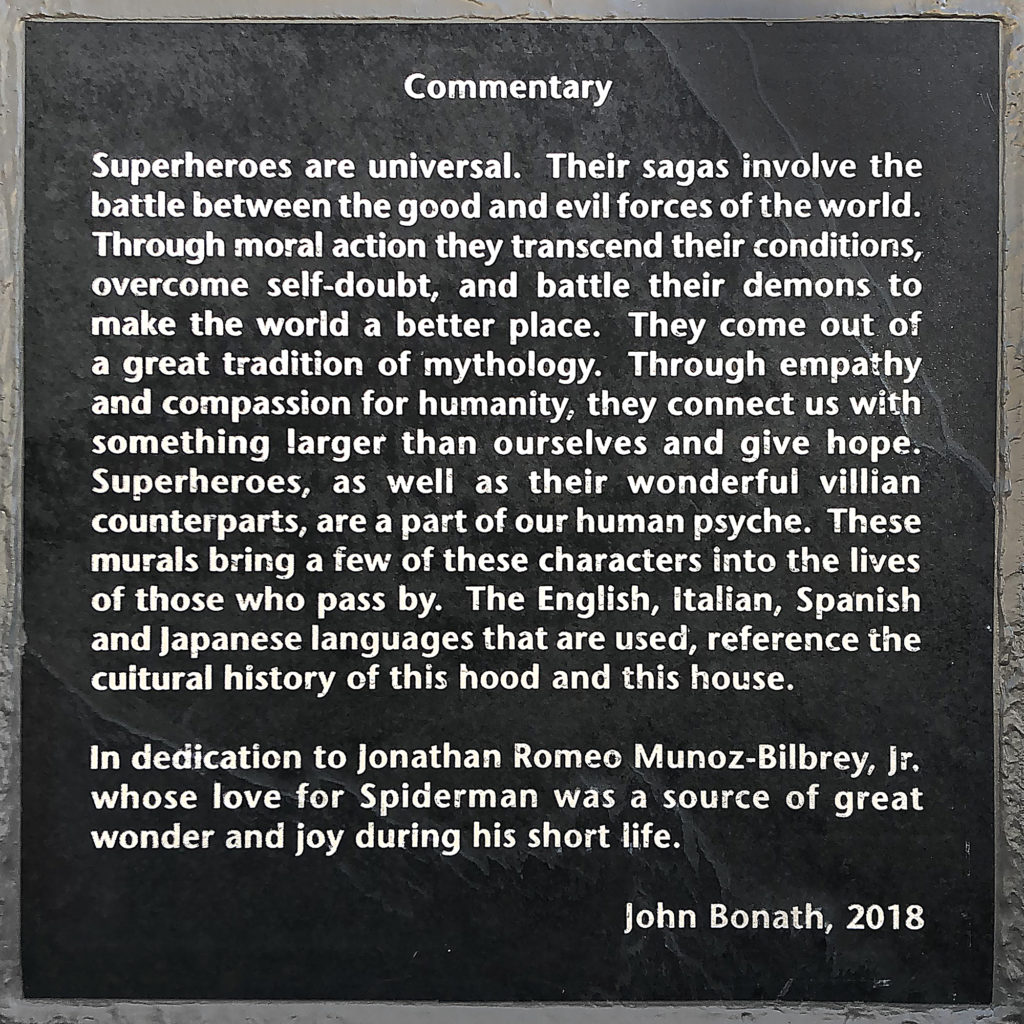

Closure
Several years after Jonathan’s young aunt rang my doorbell, and several months after the murals were installed, my path with this young woman crossed once again. She told me that she had admired the murals on the house many times in passing before finally stopping to read the plaque. When she read that it was dedicated to Jonathan, she broke down in a jolt of joy and immediately ran across the street to get her mother. Jonathan’s grandmother ran over in her bare feet and hair curlers to see for herself and the two of them stood there hugging, choked in tears. It was a private moment that happened in its own time. Such is the relationship of Spiderman and his murals to this community we call The Hood.


Epilogue
As history lives on to merge into the continuum of the present moment, the fusion forges that which is yet to come. As such, “place” is a manifestation of all that is and all that has preceded it. People and their stories are a part of the fiber that “place” is woven from. Our footprints overlap and dissolve into each others, wearing a path through time. Time may appear as a simple linear experience but it also folds back onto itself like waves onto the shore, mixing and molding memories that we all dissolve into as the collective memory of “place”, the cosmic witness to it all.
One’s roots grow deep over time with the land they claim as their “home”. It is a grounding feeling of being part of something greater than ourselves. From Father Laporte to Argentine Tango to Spiderman, I find myself caught in this torrent of connective threads and pulled towards this ordinate’s gravitational vortex. These shared stories are but a few grains of sand salvaged from the cosmic intersection at Osage and 36th. I trust you have enjoyed your visit to my neighborhood and hope you come back again sometime.
This blog concludes the series, Stories from the Hood
If you liked this series, please leave a comment and share the link with a friend.



















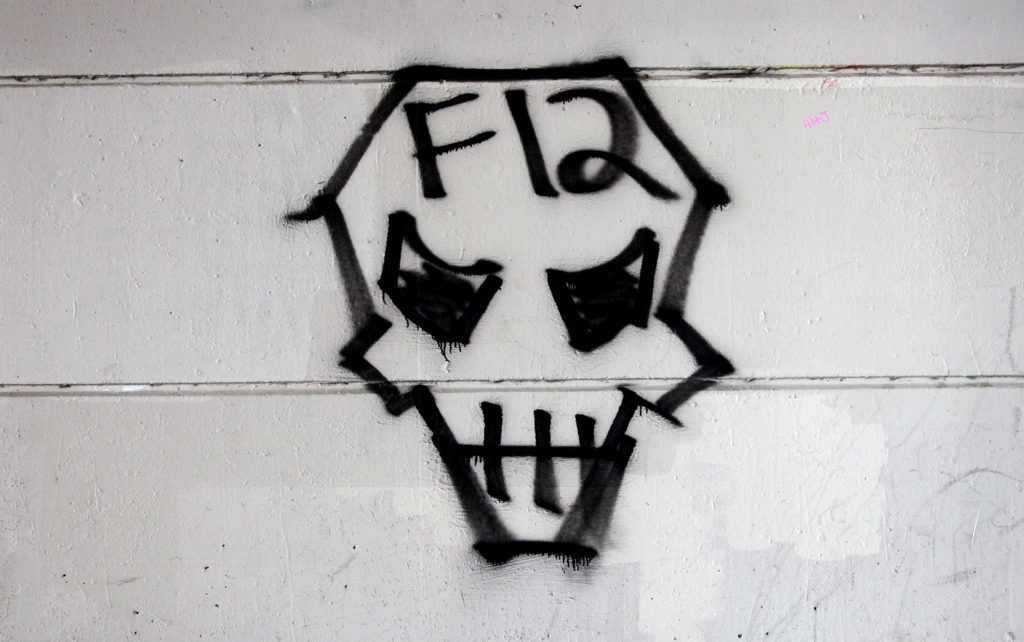































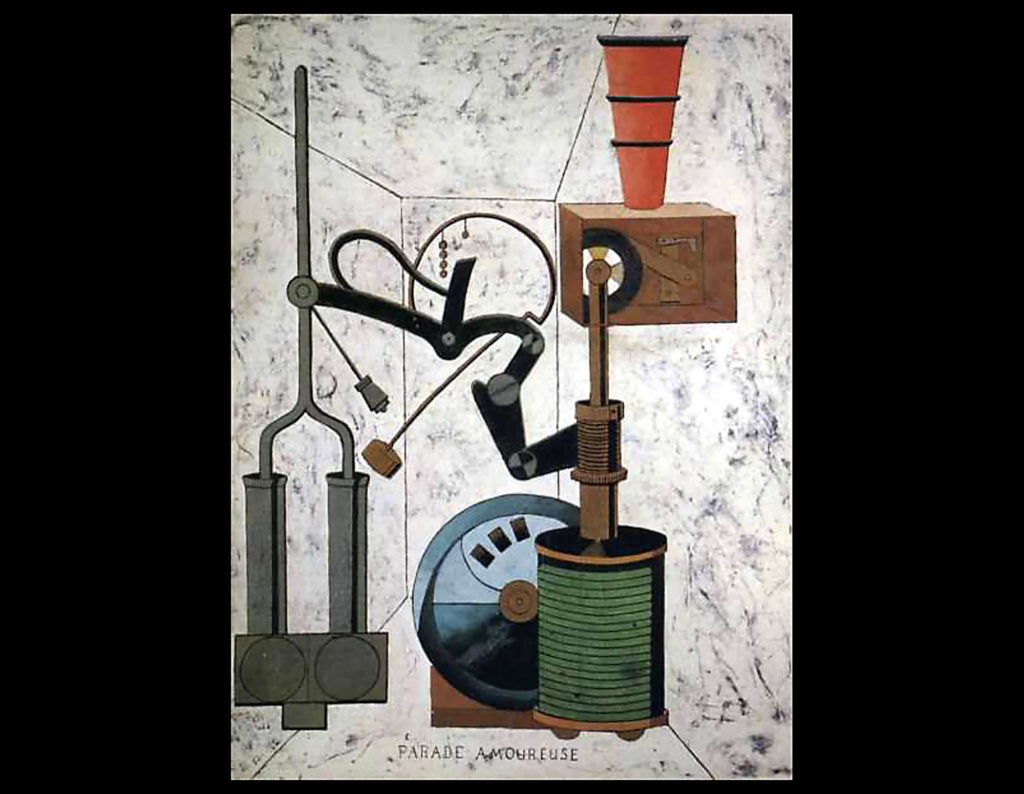
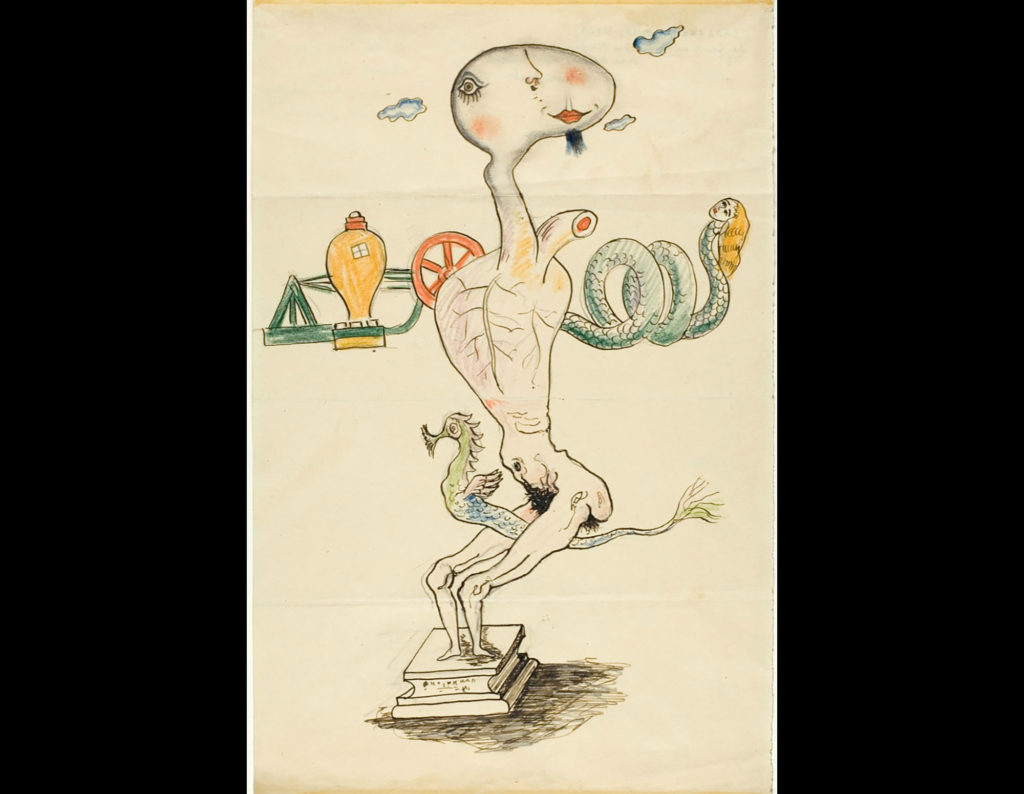


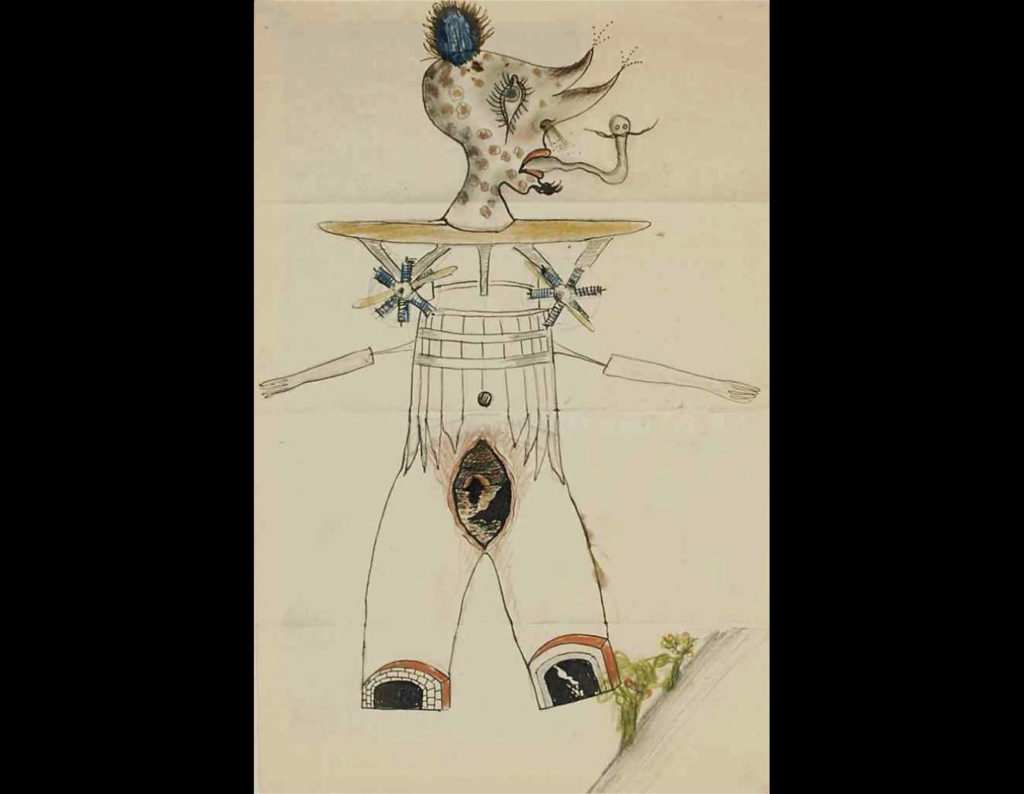
































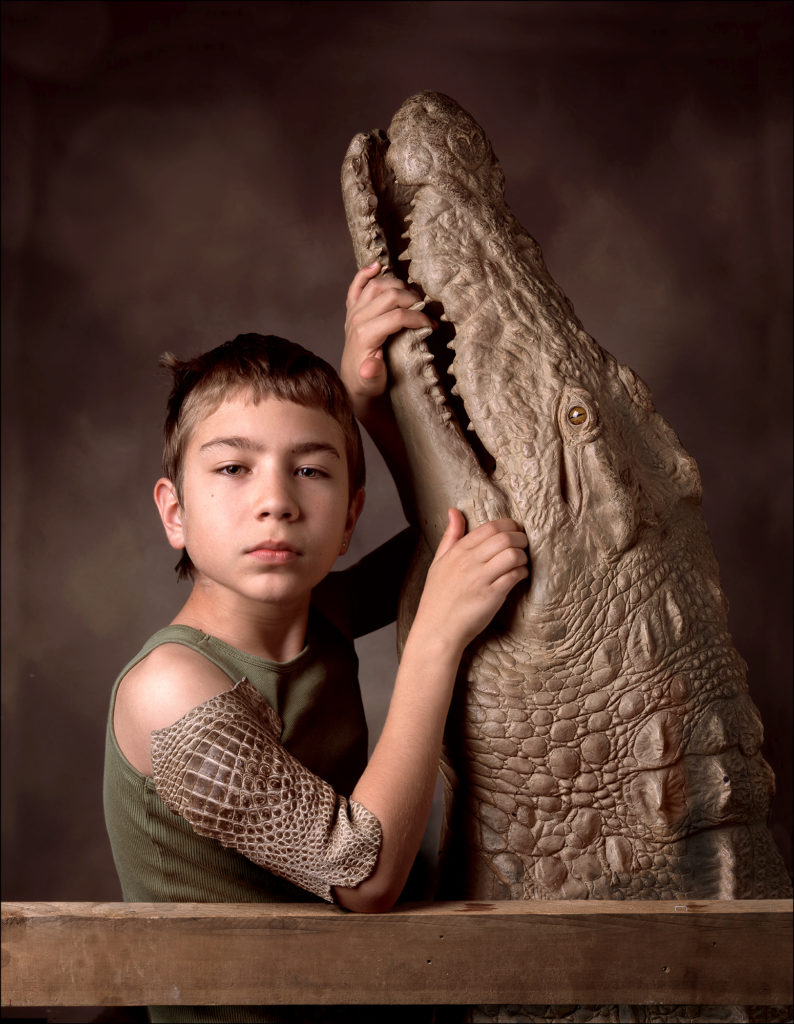
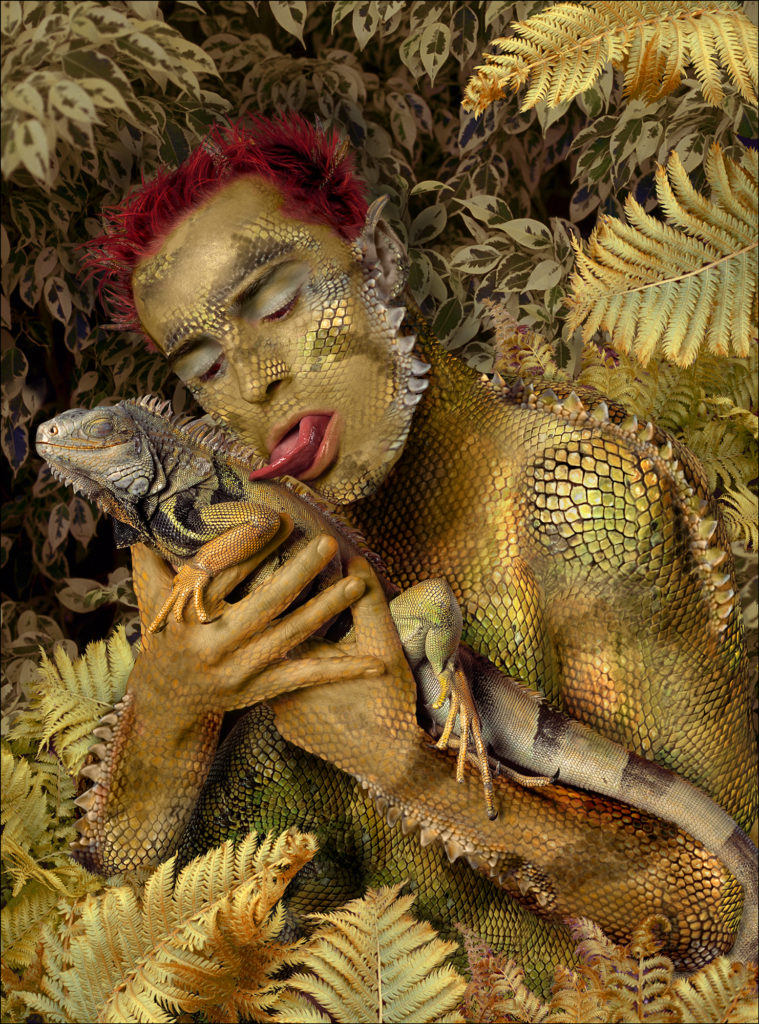


























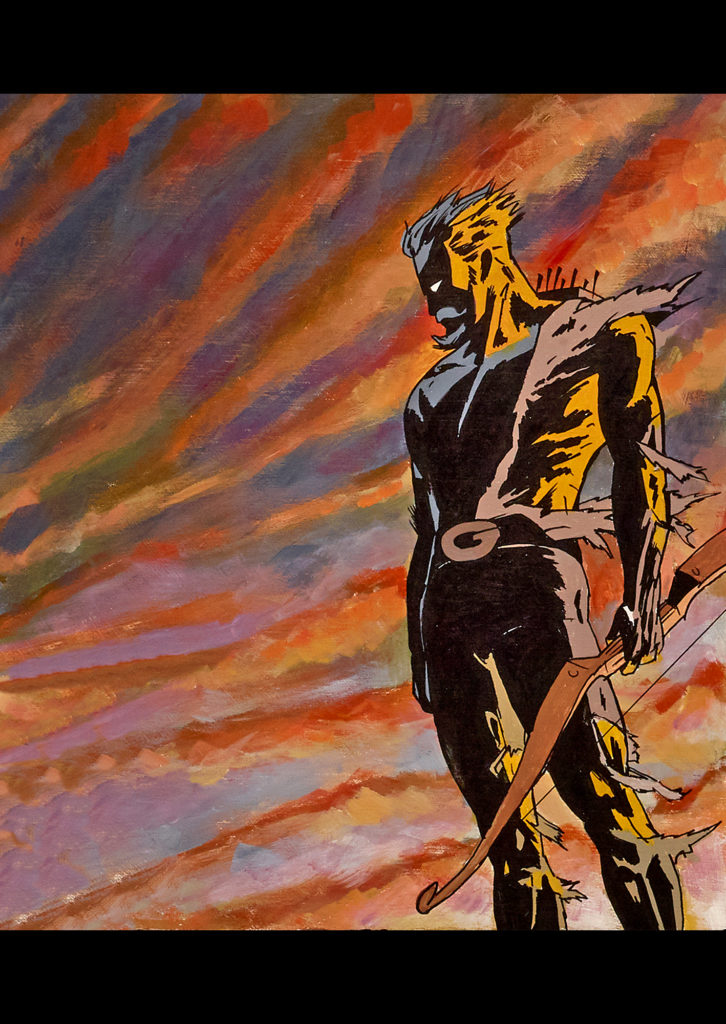



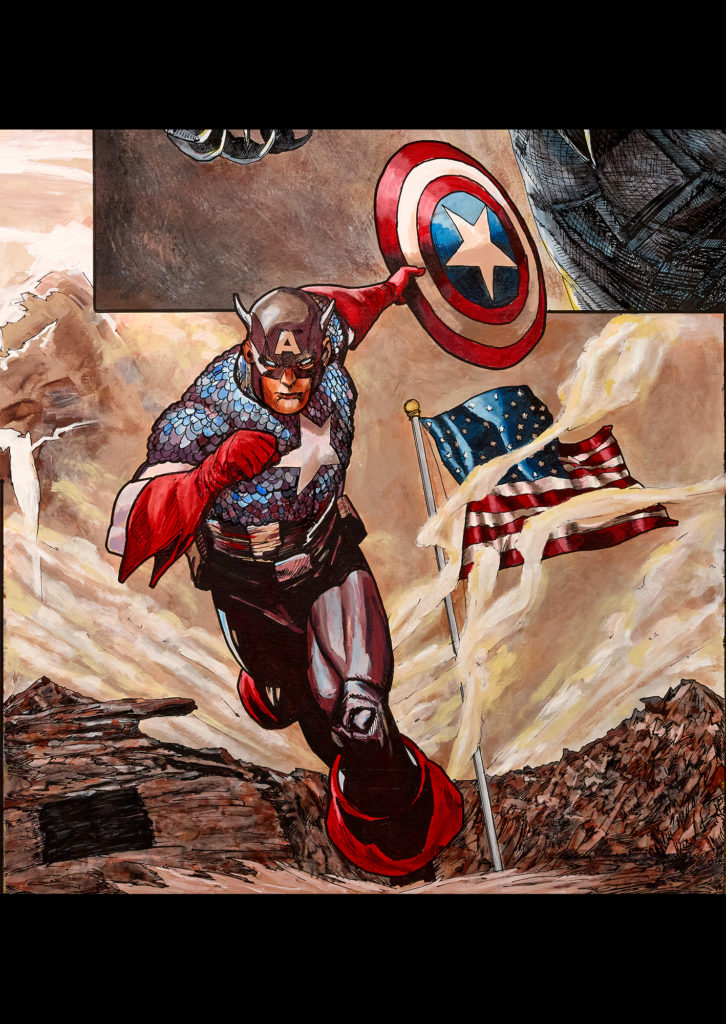








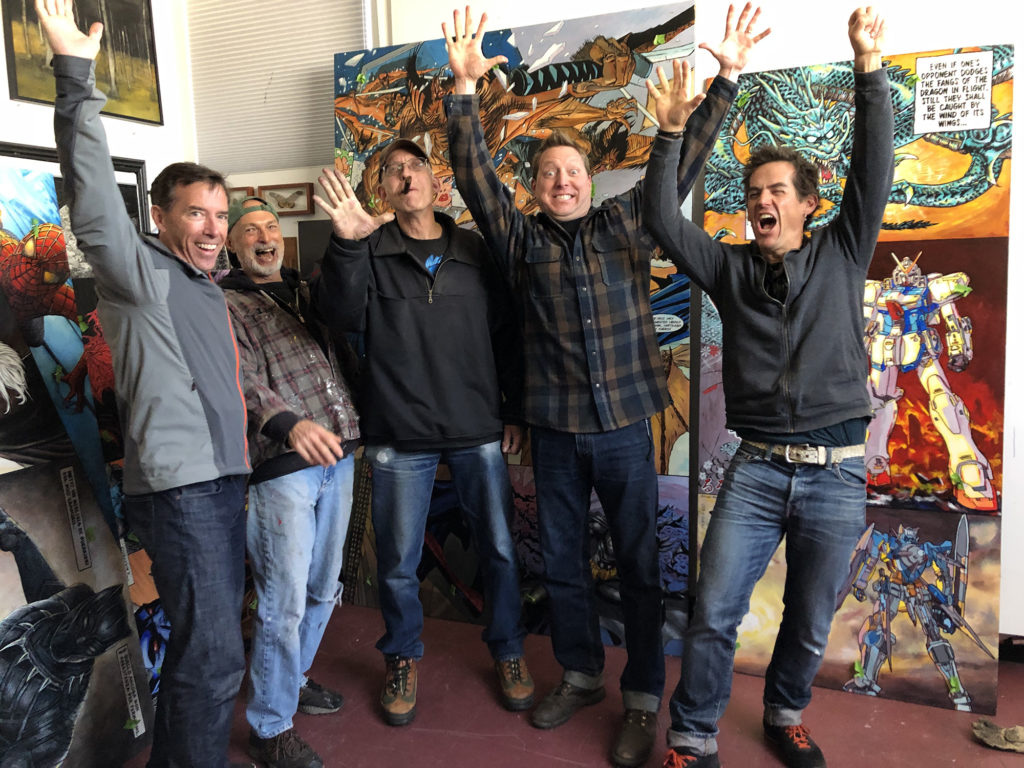



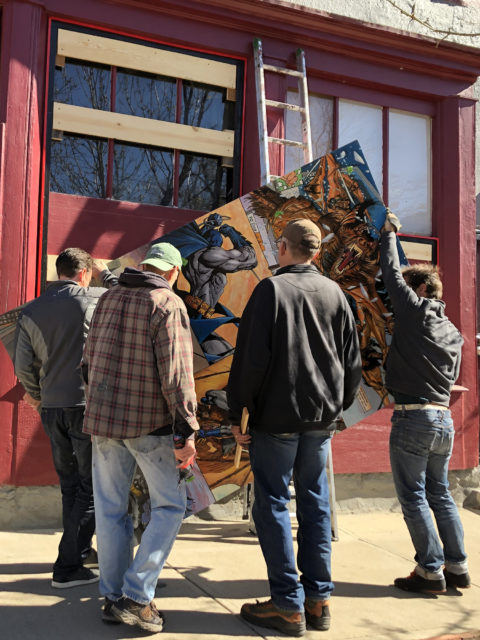






























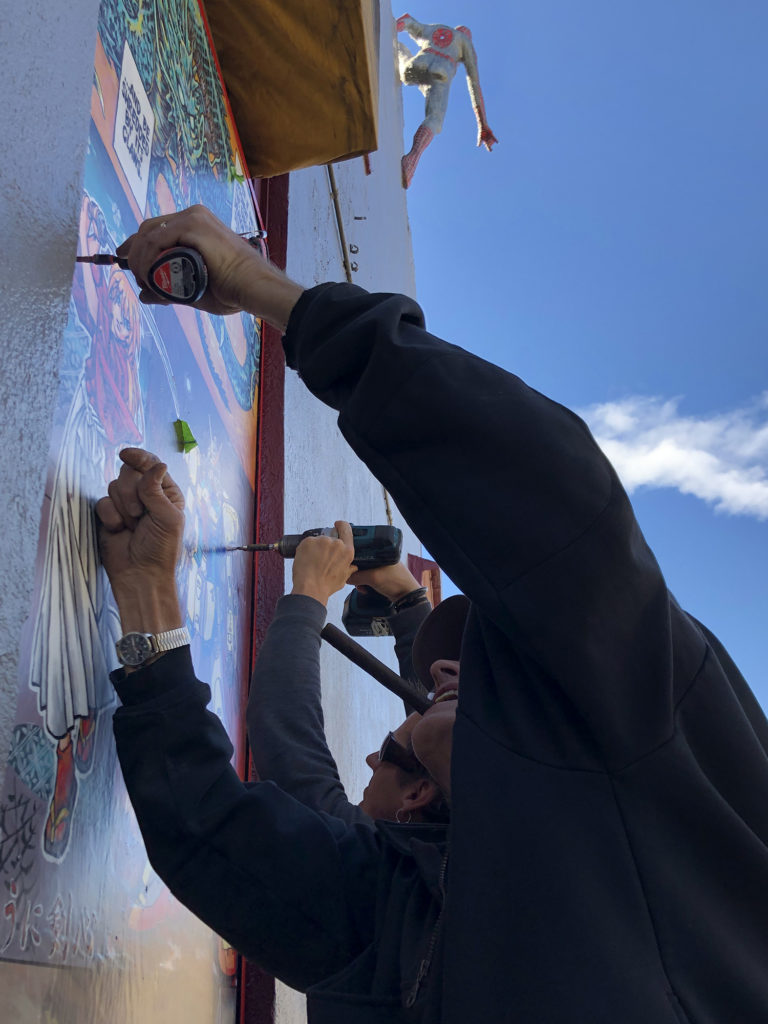













Lindy Lyman
I am blown away by the pawer of these murals and the story of their making. Thank you John for all the stories from The ‘Hood ~ and all that you continue to give the world as a wondrous artist in these times !
Gayla Lemke
Wow, John. I love this series. Thank you so much for writing and sharing these stories…so interesting and heartfelt. I appreciate you.
Sharon Brown
I have loved every minute of this brilliant blog. You give me goosebumps with your wit
And wisdom. Your appreciation of the characters and character of the neighborhood is priceless. And Jonathan….wow!
Peter
Once again your creativity, your wordsmithing, your energy, is three notches north of amazing. Thank you for sharing your stories and your art.
Dave Yust
Dear John:
I have found your BLOG series to be nothing but BRILLIANT! Each and every one was beautifully supplemented with imagery and each was so poignantly written!
I so wish they didn’t have to come to an end . . .
Pat Conrad
I have most every blog. Not from start to finish but I am always inspired to create an image after reading and viewing your work. I have to come down to your neighborhood. Seeing your murals in person would be a treat because as good as the photography of your work is, seeing art in person is the best. Thanks for the motivation to be more creative!!
Rene O'Connell
Such a beautiful story and what I’ve learned! Thank you for making me aware of this rich history. I remember the murals in your studio. Gleaming works that take your breath away
Lorelei
I loved these stories John! Reading these makes me want to revisit your neighborhood; it is truly an interesting revelation of the life of a community and all that makes it unique and wonderful! Your stories are as mesmerizing as your art…
Deb Rosenbaum
I’ve enjoyed reading the amazing story of your neighborhood, John. Although we didn’t live there, I am a northeast native Denver gal who spent every family holiday dining at Pagliacci’s. When I returned to Denver 18 years ago, Navajo was the art hub for me. Now my niece is living a block from you and I have sent all the bogs to her so she can know the history of where she lives. Thanks for sharing your story and your art with the community.
Barb Pullin / works at Reed Art & Imaging and dates Gary Reed.
I highly enjoyed your blog. You write and tell wonderful and witty stories. I love local history and photography so you had me interested from the beginning. Every Sunday morning I would read one and will miss it. You should make a book of it.
John (Johnny) Pocernich
John.
I’m overwhelmed with what I just finished reading about you and the hood. It was so well written. All nine parts to the series.
I cried a lot and felt every piece of each segment. I cant’t wait to read it again. I’m looking forward to knocking on your door to say hi and walking though the neighborhood with you. I’m still in Trinidad Colorado but moving back to Denver soon. Thank You for sharing your personal and powerful history of you and where you live. Just love it !!!
Barbara Hoffman
I couldn’t agree more with all the above comments!
We are part of something greater then ourselves as you stated. Your openness, humanity, energy , brilliant mind/talent and caring has led you to embrace and be part of that greater “stuff” in positive ways! Your stories are riveting and some of what you have experienced heartbreaking, the visuals enhancing and the final art pieces and reason for being, wonderful! I really enjoyed learning how they came to be.
Scott Scheuermann
Cousin, I don’t make the time often enough to keep up with your blogs, but when I do I leave with a smile on my face.